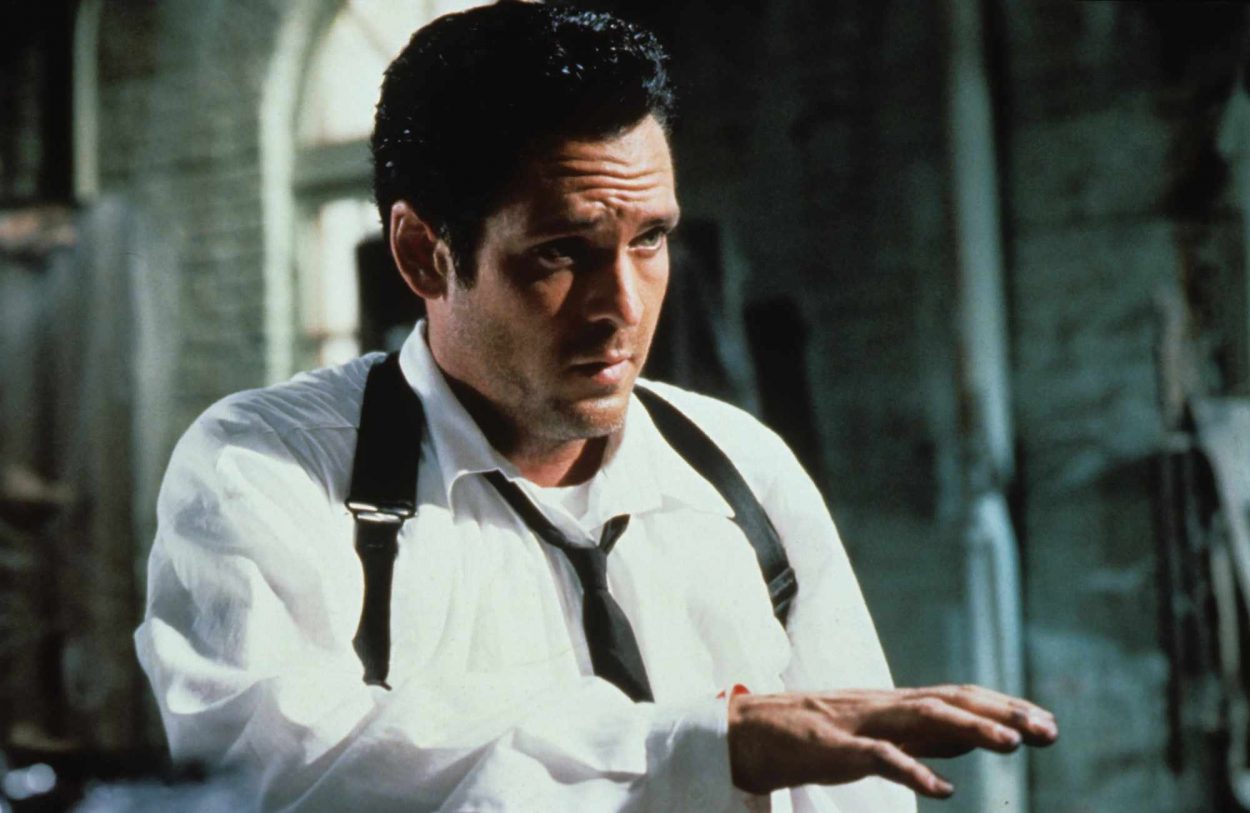“David set it up [in Straw Dogs] . . . There are eighteen different places in that film, if you look at it, where he could have stopped the whole thing. He didn’t. He let it go on . . . As so often in life, we let things happen to us because we want it to . . . I’ve had to lecture twice now, really, about the film to psychiatrists . . . They say, ‘How did you find out about this?’ Well, I got married a few times.” – Sam Peckinpah
Romantic relationships, revenge, jealousy, masculinity, femininity… these are complicated matters in life, emotionally messy matters, things that, when up against serious impediments, aren’t easily resolved by valorous, well-adjusted people doing the right thing. And often, when feeling a looming problem, and a looming problem particularly in our relationships, we act out in little ways to both avoid the crescendo of drama while subtly stoking those fires, making what we wish to prevent (total collapse) a self-fulfilling prophecy. Through committing small, nasty acts of reprisal (justified or not justified), grievances and resentment can build and build and build until they are fully ignited, gasoline poured on the flames, the house nearly burned down. This is what happens (and literally) in Sam Peckinpah’s controversial masterpiece Straw Dogs, a movie about a man struggling with his masculinity and what that even means (and unleashing his savagery when pressed in the most extreme way possible) while also observing, in most lacerating detail, a failing marriage – two people falling out of love, and indeed, when all is said and done and killed, hating each other. Scalding liquid thrown on faces, bear trap coup de grâce, bloody bodies piled up in a farmhouse. Through severe, in part, metaphorical terms, Peckinpah’s dysfunctional couple is, by film’s end, stripped of their microaggressions to see things for what they really are – they are not in love anymore and why did they get married in the first place? I can only wonder if Ingmar Bergman saw this picture and admired it. I’m going to believe that he did.
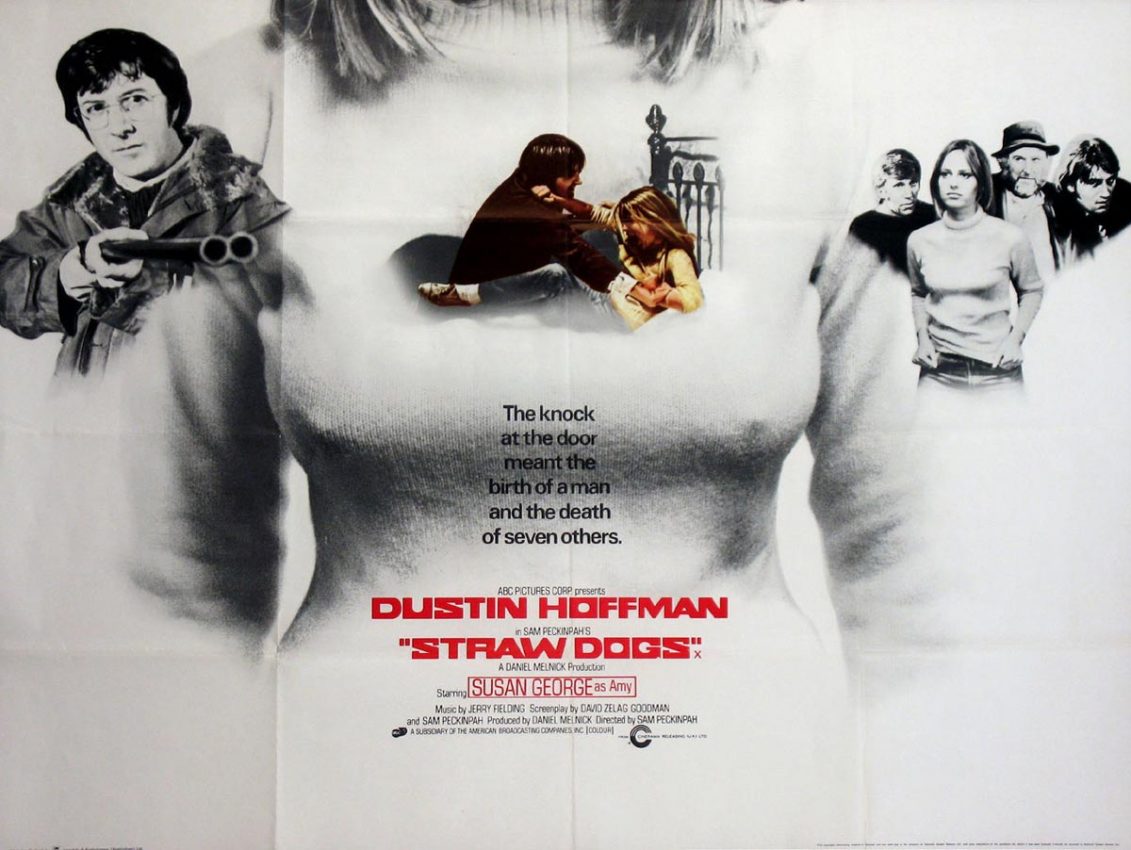
Straw Dogs opens with a Peckinpah motif – children are awful, readying to be awful adults. Like the kids torturing scorpions in The Wild Bunch, the children of this Cornish village (Cornwall, UK) are laughing and screaming and singing while circling a wagging dog in a graveyard. Though the dog’s not tortured, you sense something ominous will happen to the pup, and one can deduce that Peckinpah meant it as such (I highly doubt he opened his film simply to show how adorable little children are). Underneath all of the “cute” childhood play is a creature who could turn around and bite their little hands off. We then see the film’s protagonists walking through town, stocking up on sundries – that’s Dustin Hoffman’s American mathematician David Sumner and Susan George’s Amy, David’s young and beautiful British wife. George gets an eyeful of an introduction, something that’s offended and titillated viewers and critics since its opening: wearing a white sweater and jeans, she is braless, and Peckinpah takes visual notice of this right away.
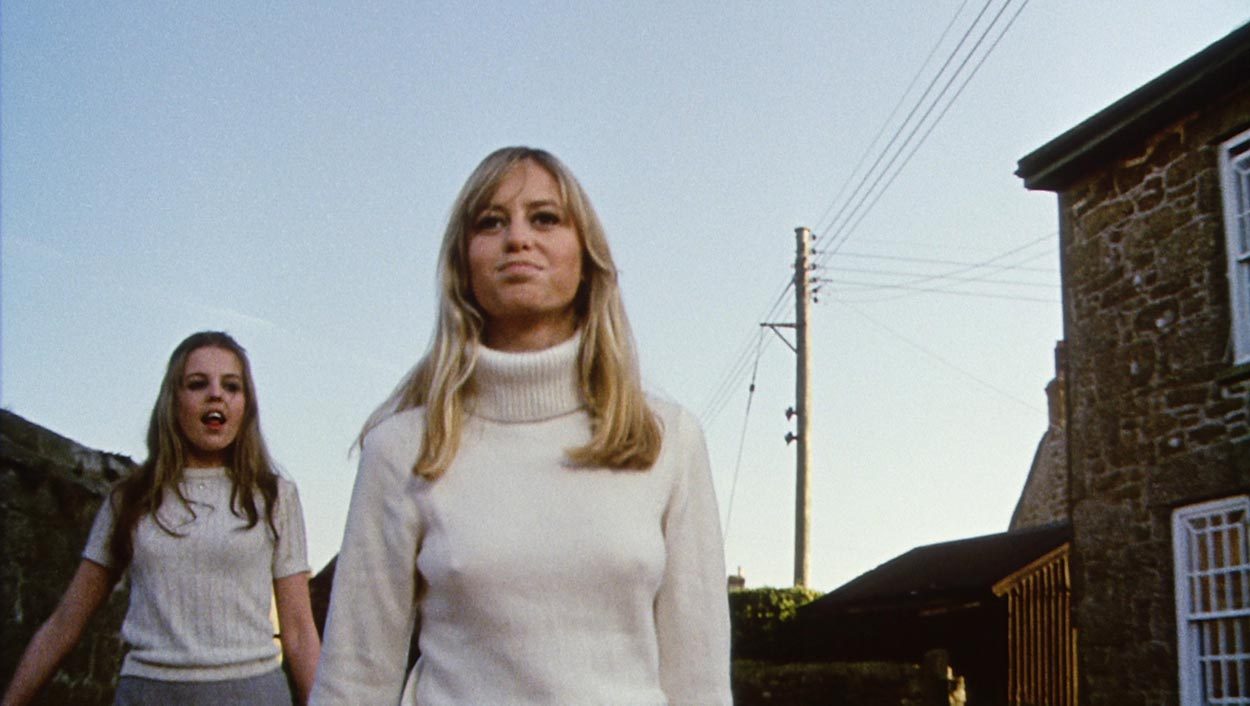
The male gaze is exactly what Peckinpah has placed front and center (even if women also look at and admire George), as you feel a palpable sense of dread, the townies staring at her as we stare at her, making us feel immediately aroused, and some of us uncomfortable, perhaps even complicit, and a little sorry for Susan George who is simply braless. To a young woman in 1971, going braless wasn’t that big of a deal, and for some (then and now), even if she knows everyone is looking, she doesn’t really care. And why should she? Yes, it’s always wise to assess the danger of your surroundings (and David brings it up later, though with little concern, this isn’t James Stewart lecturing Lee Remick about wearing a girdle in Anatomy of a Murder), but the idea that she deserves any kind of aggression based on her lack of an undergarment is absurd. I can’t believe that I’ve read this subtly questioned, even in reviews from the 2000’s. I recall reading that Amy was “gallivanting around” in one piece, which suggests she’s being overtly ostentatious in her attire. Jeans and a turtleneck sweater? I’ve seen sexier getups worn by Marcia Brady on “The Brady Bunch.”
So … maybe Amy just doesn’t like wearing a bra and Peckinpah noted how men view this and placed us directly in that view. It may come off as exploitation at first but it serves a purpose throughout the entire picture. Amy is both knowing and wagging a big middle finger to those who look. Both times she’s caught in erotic visual (topless in the window, or her mini-skirted leg and panties from the car) she stares down her gawkers more with a challenging “what?” than a flirtation. That many critics view this as merely flirting seems strange to me, not taking in the complexities and the impressive subtly of George’s performance.
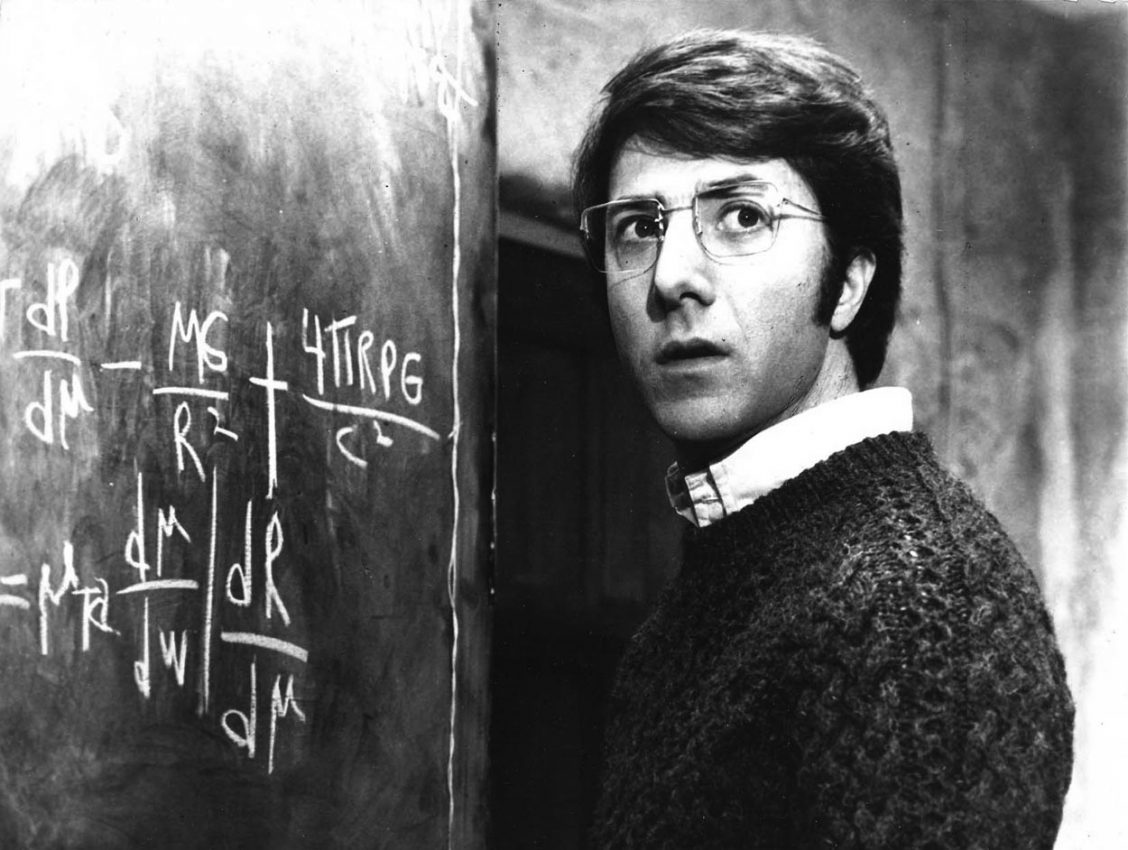
But that kind of liberated manner is scary in this setting and furthers the animosity the locals feel for Hoffman’s American, whom Peckinpah also describes via wardrobe – ineffectual, sweatered-preppy in white tennis shoes, walking into a pub full of hard-drinking manly men who clomp around in work boots and scruffy beards. David even requests American cigarettes. You feel sorry for him too. He’s immediately an outsider. This is Amy’s hometown and so the watchful locals may make her feel both more comfortably accustomed to their roughness and wary at the same time and yet, she must know they resent this return. Already a man she’s had romantic involvement with, Charlie Venner (Del Henney), is getting aggressively fresh. But you get a feeling, immediately, that something is not right in David and Amy’s marriage; that it likely wouldn’t have worked out even in a different setting. It’s just that this was the entirely wrong town to relocate to. This will be the place to inflame their already apparent strain. Much like the way Guy and Rosemary Woodhouse make a fresh start at the Dakota in Rosemary’s Baby, you can already see the tension before the Satanists show up.
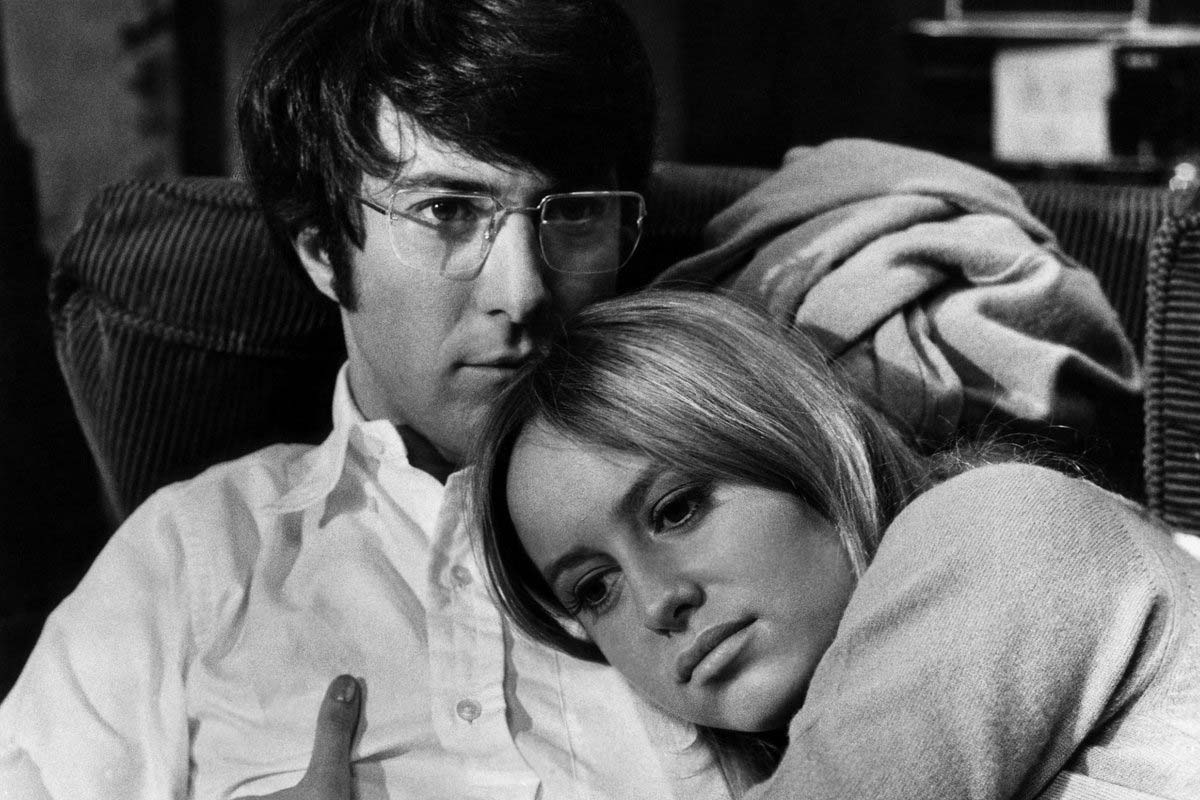
So much of the picture is building on this dread and animosity – between the villagers with the husband and wife, and between the husband and wife alone, that every little infraction is loaded. David has left the states during the Vietnam War (some believe Peckinpah viewed this pacifism as cowardly, I do not think it’s that simple), and he’s trying to accomplish work on complex math problems in the farmhouse. At one point he tells a worker, Norman Scutt (Ken Hutchison), why he ventured out there: “I’m just glad I’m here where it’s quiet and you can breathe air that’s clean and drink water that doesn’t have to come out of a bottle.” It’s an innocuous yet amusing line because, one it’s timeless, someone would say that now, and two, nothing appears bucolic in this town at all – not even the air. Muscularly shot by cinematographer John Coquillon, the town is potently grimy, where nature is tangled and cold, the green of the earth damp and dirty, everything is effectively oppressive, a place where people are self-medicating illnesses (physical and mental) at the pub, and disease-ridden rats are proudly caught by a giggling rat catcher psycho named Chris Cawsey (Jim Norton) who sings this dreary little ditty: “Smell a rat, see a rat, kill a rat!”
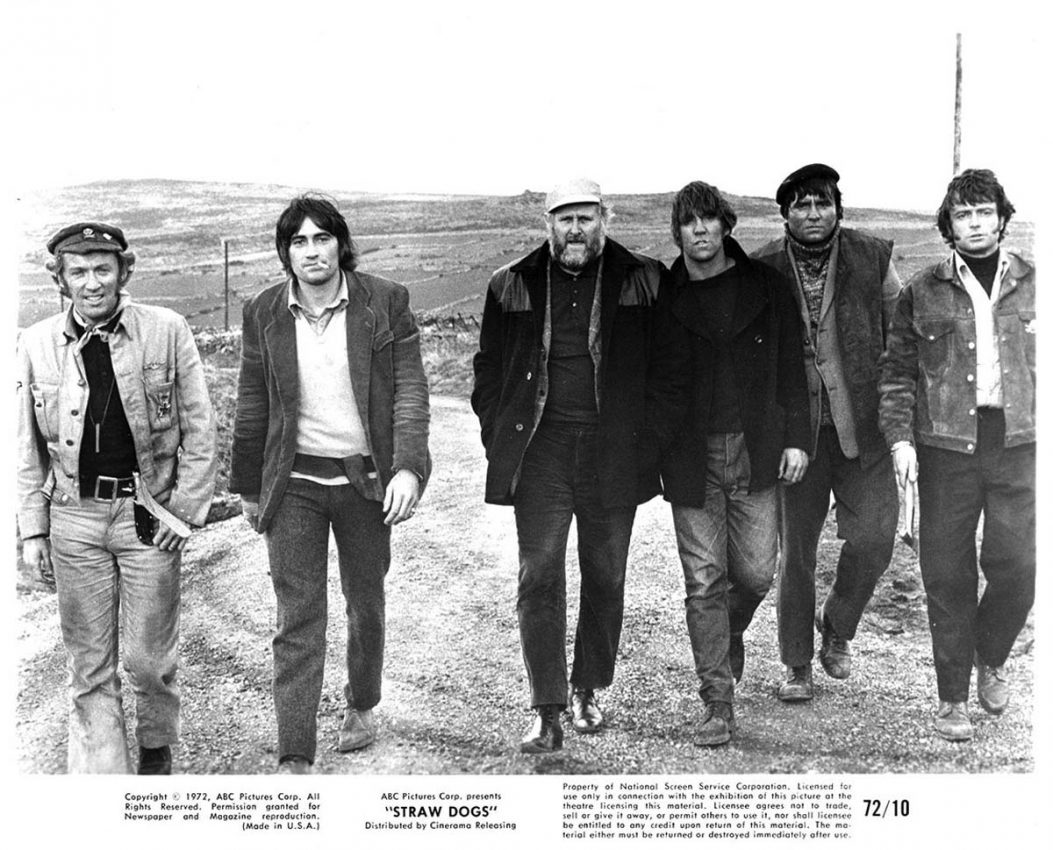
Amy and David are always being watched while the men working on the farmhouse lewdly discuss Amy’s attractiveness with perceptible violence, even stealing a pair of her undies. They don’t like David, whom they view as weak, and laugh at him as he attempts to start his sports car – an emasculating moment, backing up when he means to move forward, accidentally turning on the windshield wipers. Amy is the better driver, and the more reckless one as well. People may consider Amy as the most reckless at everything but I believe they both are. Or rather, everything around them is a torrent of recklessness, fueling their normal transgressions.
Adapted by Peckinpah and David Zelag Goodman from Gordon M. Williams’s “The Siege of Trencher’s Farm,” some changes in the script made the disparity between the couple more evident. Their ages – younger – and Amy young enough for us to assume she was once David’s student. The dynamic of teacher-student crush is now colliding with real life, with nature. That whatever intellectual control David had over her before, he is losing his power, and especially in this turbulent, rugged environment. Their bickering is that of a focused academic who doesn’t take his wife seriously (she also seems quite a bit more affectionate than him) and a wife who seeks respect and validation, even if she has to be annoying to get it. Amy is unhappy, even tortured at times (you can see it in her eyes), and young actress George displays this in knowingly subtle ways. She does small things to show her annoyance – crossing out a plus sign to a minus on David’s blackboard, even sticking her gum on it; talking to the workers only to mock David by telling him they think he’s “strange;” yelling at him to question the workers over who hung their cat in the closet (this seems pretty justified, though it would be hard to approach a group of intimidating men, accusing them of killing your cat).
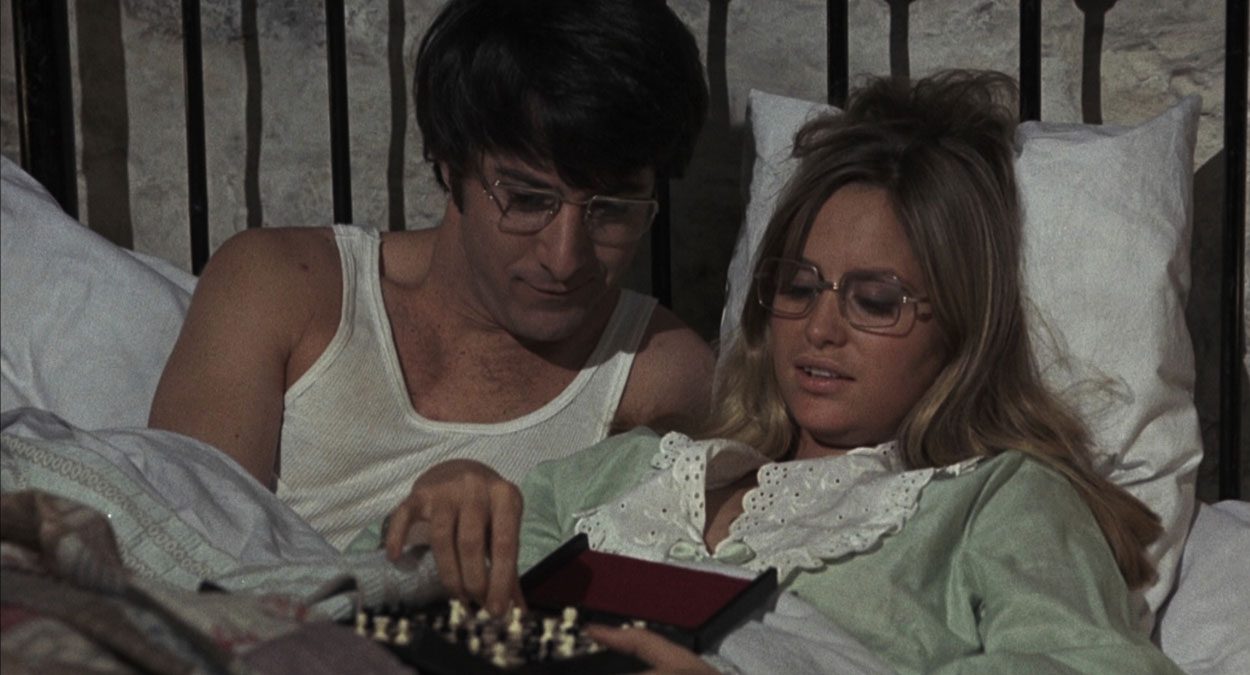
They’re bickering like an old married couple while playing up their roles, perhaps to restore their attraction. In one scene, David gazes at Amy flopped out on a chair and remarks that she looks like a 14-year-old. He playfully drops the age to 12 and then 8, as she vamps up the Lolita wife by smacking and chewing her gum like a sexy teenager. This works for them. In that moment. But not-so-Lolita Amy has her small victories. Like when David says she’s smarter than he thought because she actually understands a mathematical concept or that Peckinpah shows her playing and studying a cerebral game like chess before going to bed. Amy wants to win at something and if chess won’t be taken seriously enough, her sexuality might, and so that sex, her braless beauty, hovers over the picture as, not just a torture device or Amy having it coming, more as impending doom through sexual extremity.
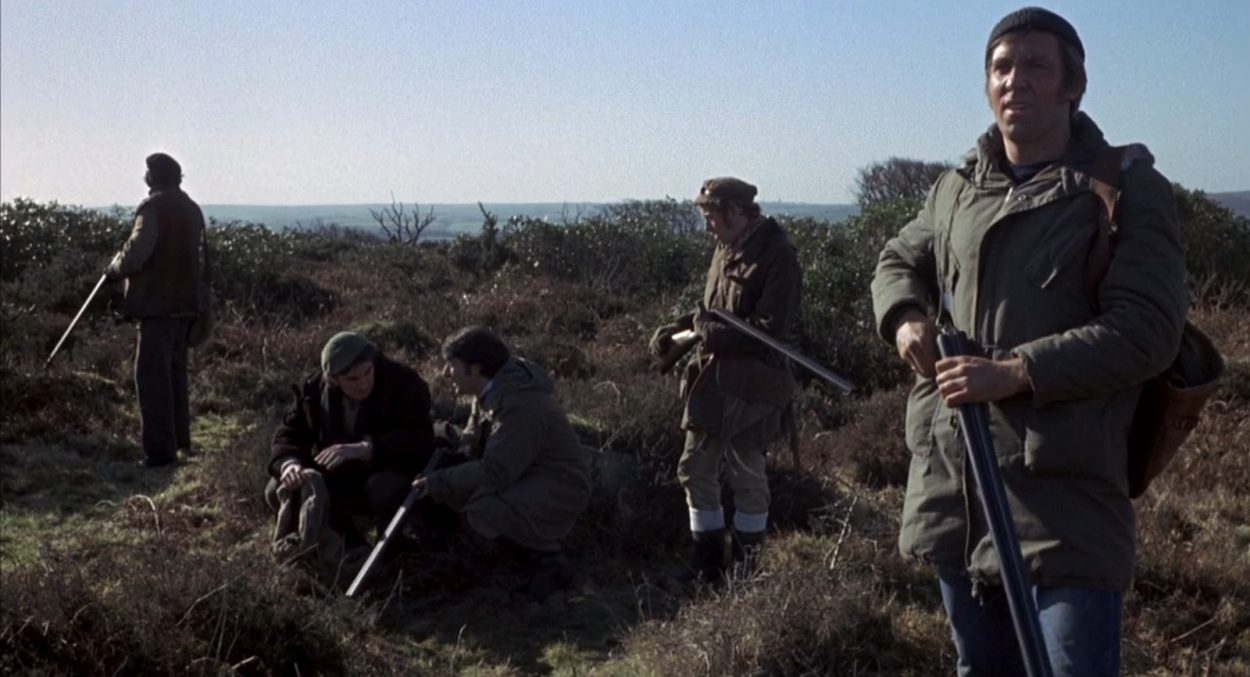
The working men invite David out to hunt and humiliate him further – they ditch him in the woods and one calls on his wife. Charlie Veneer returns to their farmhouse where Amy is alone. Here begins the notorious moment that has been studied, argued about, upset or confused critics to this day: in a meticulously crafted scene, through expertly horrific, ferociously real and yet, hallucinatory directing, editing and performance, Charlie rapes Amy. And then Scutt sodomizes her. It starts with Amy rejecting Charlie’s advances, but he overcomes her on the couch. Peckinpah does not spare Amy, her clothes are ripped off, breasts revealed, her quaking fear so evident you know (and this was indeed true) that the actress is terrified herself. What offends many is that Amy eventually succumbs; she climaxes and holds her ex lover tenderly. When Scutt sneaks in, unbeknownst to Charlie, Charlie at first tells him no, but then, disgustingly siding with a buddy over a woman, holds her down while Scutt rapes her. It’s horrifying, Amy convulsing in terror and pain. Critics who loathe the picture feel that Peckinpah is suggesting that Amy is asking for it, through her attire, through her flirting (I still don’t view her as merely a flirt) or, that craving his masculinity, she’s turned on by Charlie’s brutality. I don’t think it’s quite that simple (though I’m not going to tell anyone what they should or should not be offended by). Amy is being victimized by someone she knows and, in my view, could be submitting to save herself from being further brutalized. She can’t overpower him. She can’t even move. It’s shocking and unhealthy and it makes her feel undeservedly guilty. To underscore this, the scene is intercut with David out in the woods, feeling like an idiot for trusting the brutes, holding a lifeless bird he shot with the look of someone who is thinking, what is the point of this? He’s no idea what is happening to his wife – making the rape also serve the purpose of ultimate cuckolded nightmare – something he’ll later learn and replay in his brain over and over – that she liked it. This is what men might think, even if a woman does not enjoy it. And this it is where many critics draw the line. Amy is traumatized and suffers a traumatic flashing, which returns to her in recurring trauma that will likely never leave this woman. Never mind the man’s issues. Amy has to live with this. It’s a fucked up moment, complicated and troubling but no, nothing Amy deserves. And I don’t think Peckinpah would view it quite that simply either. Though I’m sure some would disagree with me.
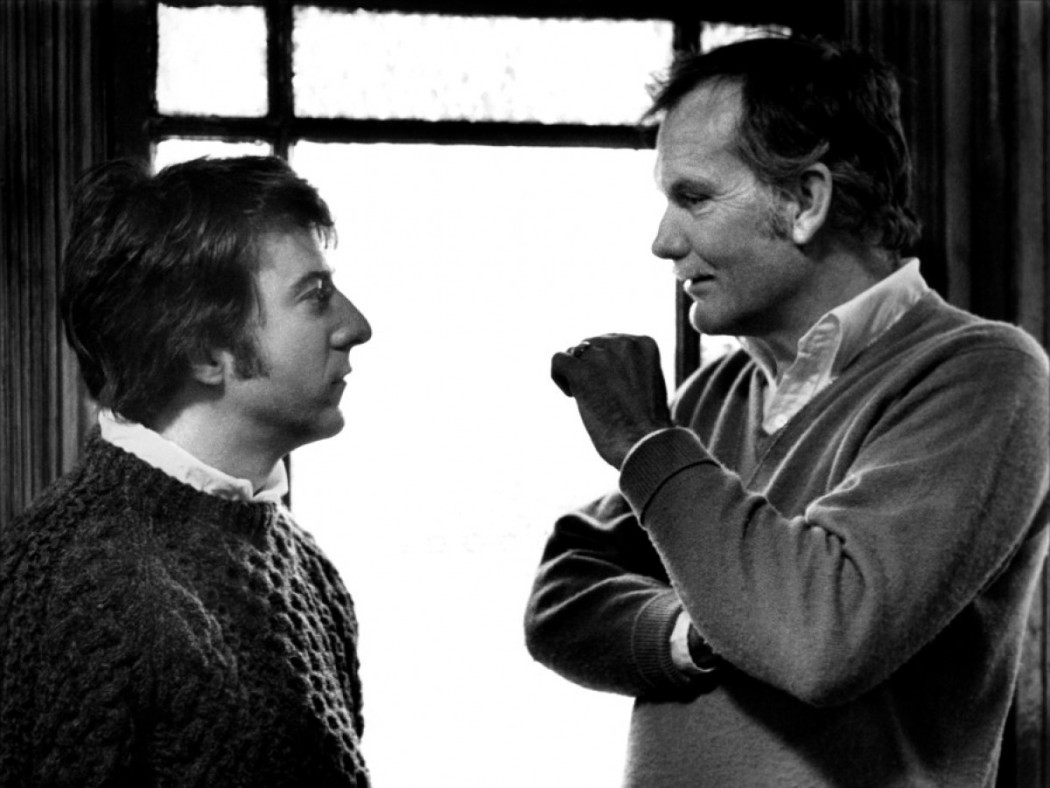
And this movie was very personal to him, according to Peckinpah biographer David Weddle (“If They Move . . . Kill ‘Em!: The Life and Times of Sam Peckinpah”). As discussed in the biography, the director’s soon-to-be wife Joie Gould was apparently a version of Amy, and David a version of Peckinpah:
“The costumes used for Amy in the final film bore a striking resemblance to Joie’s own wardrobe, and Dustin Hoffman wore many items that could have been pulled out of Sam’s closet. (Peckinpah was dressing – coincidentally or purposely – more preppily than he had in the States.) Peckinpah was not only using his own past as raw material for the film, but manipulating his present, himself and the people around him, to help feed the psychodrama. A dangerous game, as Joie would learn the hard way … The slightest smile or exchange of pleasantries with another male would throw Sam into a fit of jealousy. By the time they returned to the house in the evenings his eyes were two red pulsing sores and his mood swings were rapid and unpredictable. He flew into a rage at the slightest provocation.”
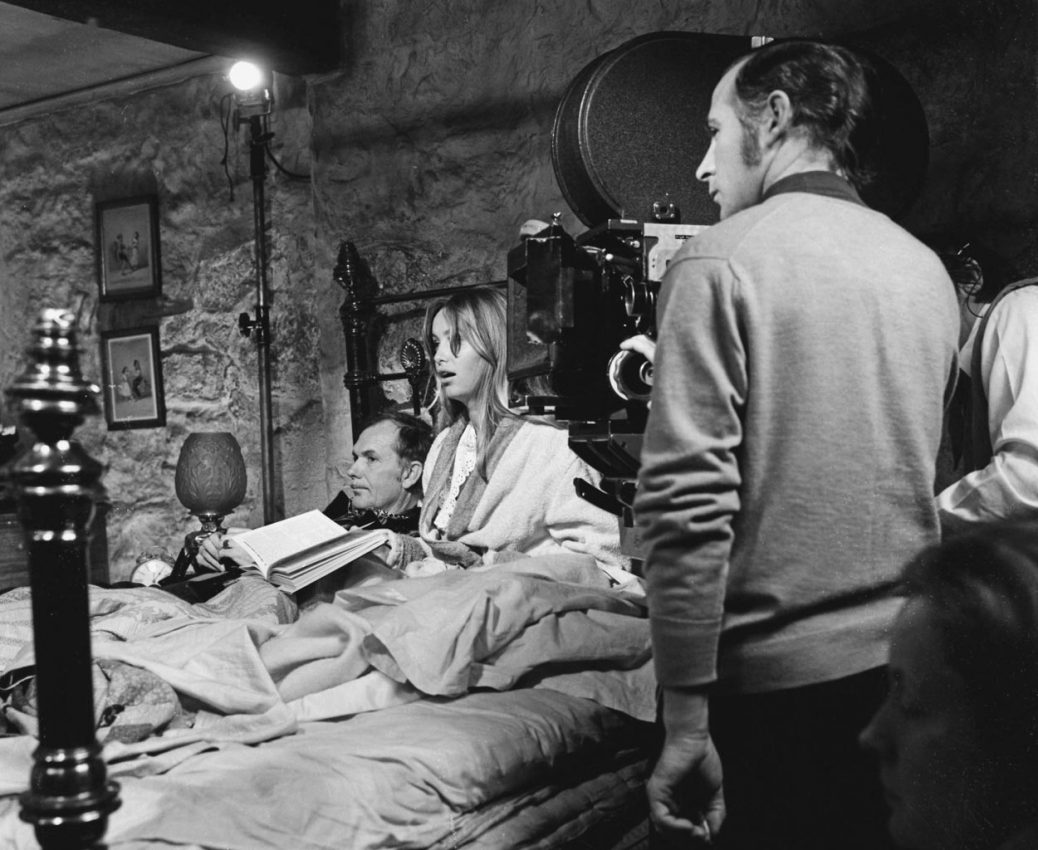
That some critics believe Peckinpah sided with the savage men of the town, and the savage unleashed in passive David seems too simplistic – that he was picking sides and not, perhaps, addressing problems within himself. Pauline Kael famously called it “the first American film that is a fascist work of art.” (Peckinpah was incensed by this review). The director likely viewed himself as both type of man, which, by film end, David is. The film is hard to wrap one’s mind around, or place tidily in a box (just as A Clockwork Orange, also released that year, was and still is) as it confronts the difficult realities of innate savagery – and not for the better of us. But not for any better or for worse – that Peckinpah is observing it’s there and in David’s eventual circumstances, he’s going to unleash (for protection, but also for satisfaction). Even as the brilliantly choreographed siege (arriving from even more violent/sexual hysteria) which takes over the final third act of the movie, is as exciting as hell, it also underscores how fucking unfair everything in this movie (and life) is.
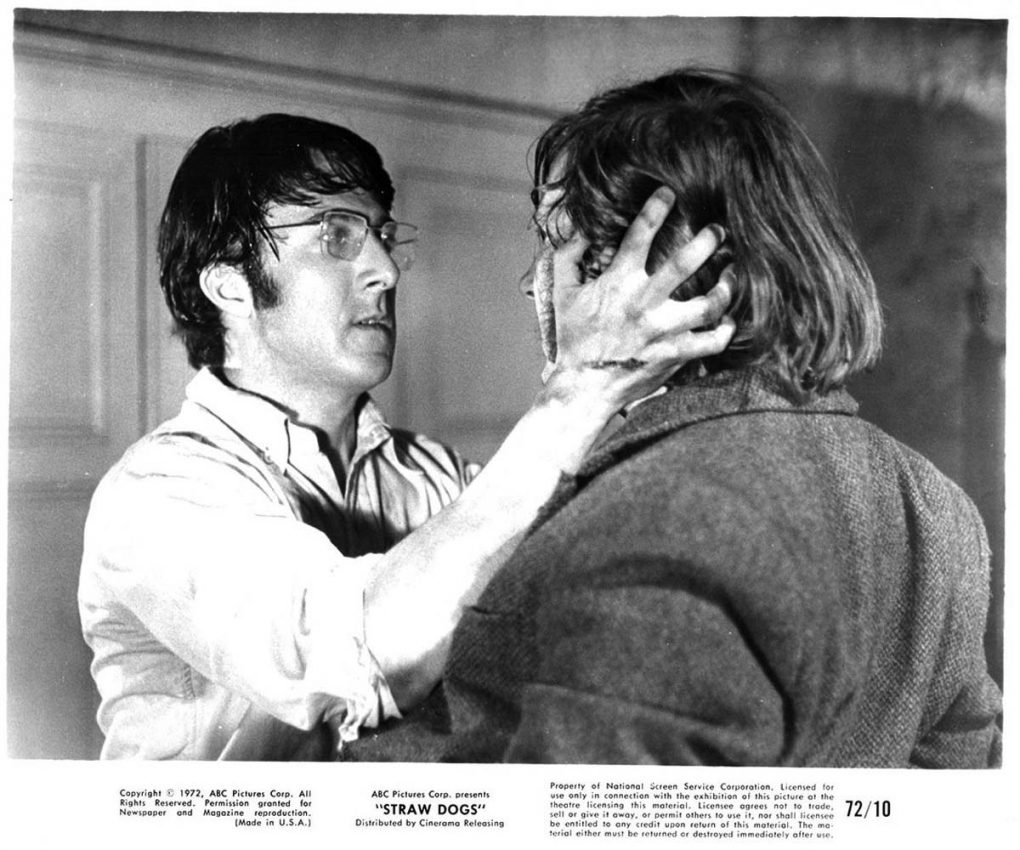
The emotionally disturbed (or simple, one might say) Henry Niles (David Warner) has gone off, quite innocently, with teenager Janice (Sally Thomsett) which enrages her father – the stupid, volatile Tom (Peter Vaughan) – and he rounds up a group of townies, including Amy’s rapists, to find her. Of course they blame Niles who, in an Of Mice and Men-Lenny moment of fear, accidentally chokes Janice to death. Amy and David have left the church party since Amy cannot stand the sight of her rapists, and David hits a fleeing Niles with his car. Taking him home against Amy’s objections (no one in the town trusts Niles), David refuses to release him to the lynch mob outside the house. David finally takes a stand, and not necessarily for his wife – she has turned against him but is now forced to help him because what else can she do when marauders are breaking into her house, ready to kill them? David is sticking up for himself, for his home and for Niles, though Niles seems more a symbol of his rage and pent up frustration, an innocent who inadvertently isn’t innocent (and maybe a savage too, after all he attacks Amy; David slaps him and says, “No,” to him like a misbehaving child). Niles is an enormous organism of confused impulses and guilt, and perhaps, helps David focus his rage to act and think. And David thinks fast when combating such radical violence and horror.
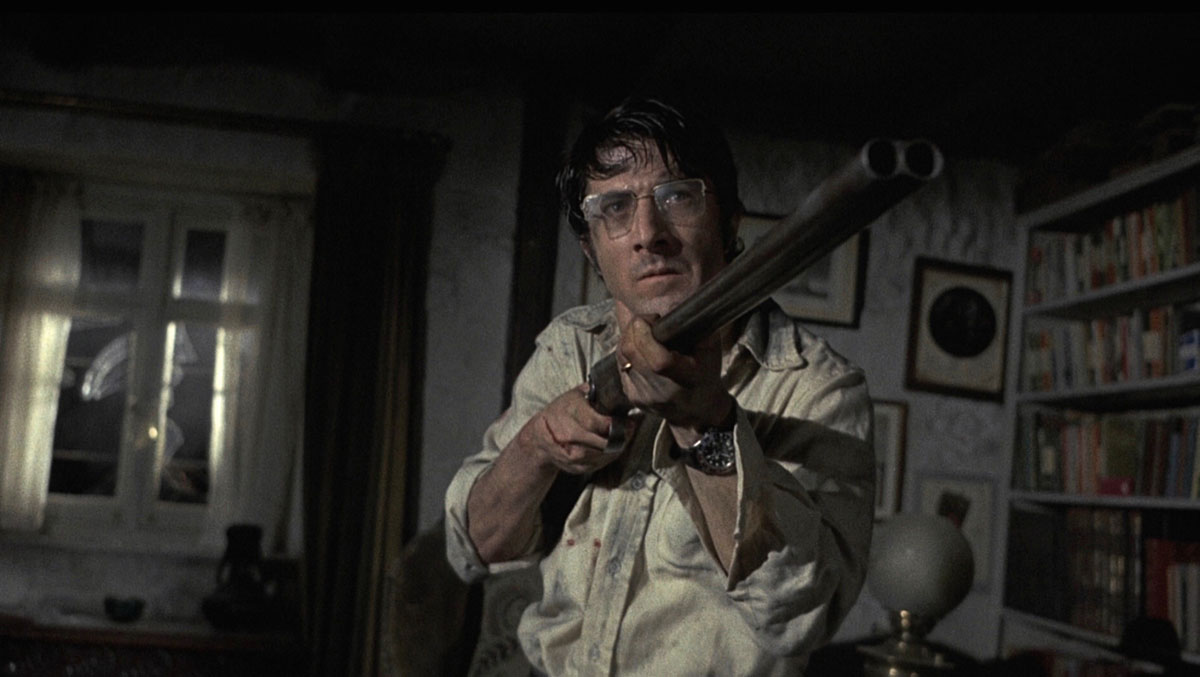
A few critics at the time saw this as implausible and even melodramatic, but to me it’s a vicious fever dream of not just David’s inner barbarian, but of marital discord exploding to bloody bits – every passive aggressive slight, every sexually unfulfilling night, every jealous moment, every moment of feeling lesser, either intellectually or physically, coming to a literal boiling point of hot oil tossed in a rapist’s face. Much like Warren Oates’s Benny channeling his pain and rage and revenge into a flurry of focused madness, driving with that bloodied head in a sack in Bring Me the Head of Alfredo Garcia, David must preserve his self-respect, through retribution. But does he? Oates’s Benny has more loving reasons – he’s lost his love to death, and, dammit, “nobody loses all the time,” as he says, but, perhaps through everything, David loses anyway, because there’s nothing romantic about his vengeance. The brilliant Alfredo Garcia, though dark and unsparing, is also romantic, as is The Ballad of Cable Hogue and The Getaway. But David’s just lost his love to … life. To marriage. All pretense is removed as David (and Amy, I think people forget Amy does help David, even if she resists, ready to bolt out the door towards the townies) defend what’s left of themselves against this leering, loathsome, all-impulse, no-thought mob – hypocrites, since they see no connection with their rape of Amy to anything Niles has done.
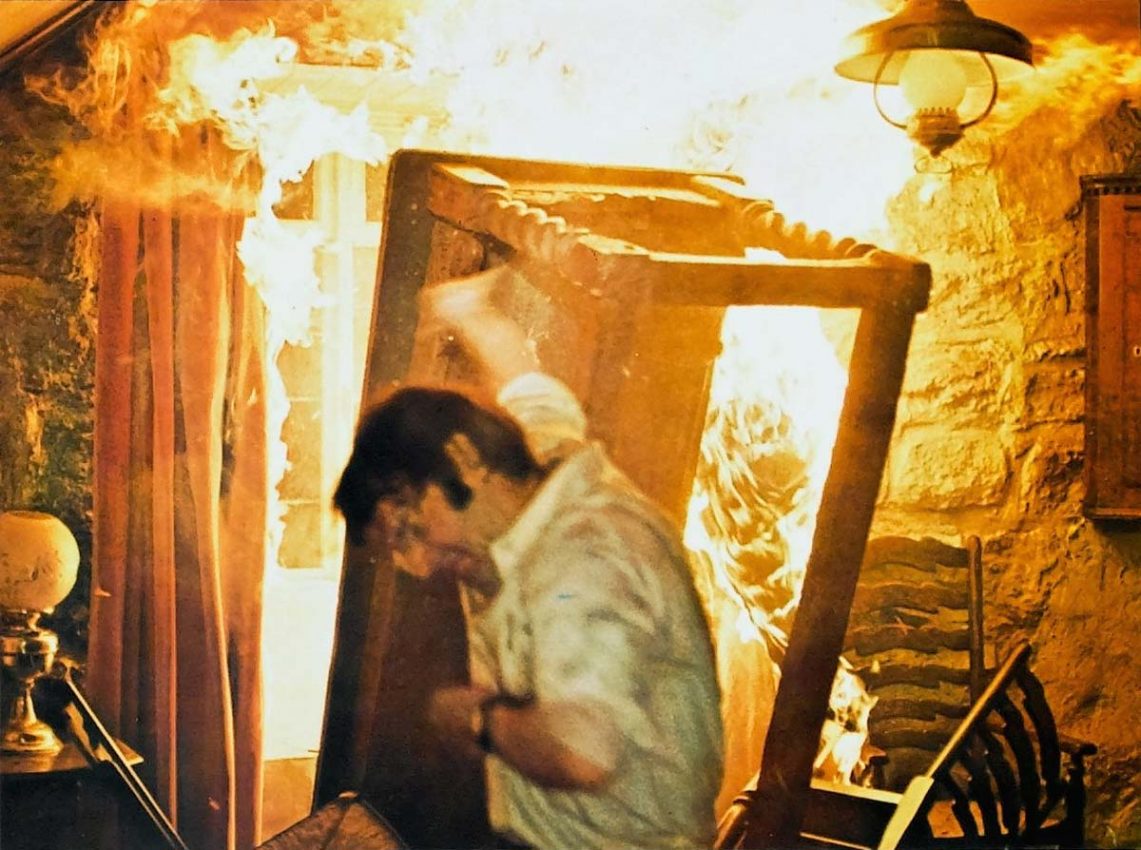
Amy is just doing what she’s told, we’ve no idea if she’s going to stick around (doubtful she will) as this Frankenstein creature is saved, the child they wrought. The idea that this is a merely anti-liberal, pro-violence movie in which savagery triumphs over passivity seems too easy for such a difficult story with such confused characters in such extraordinary circumstances. As David drives away with Niles, Niles says, “I don’t know my way home.” David, smiling, curiously, remarks, “That’s okay. I don’t either.” Did he find himself through becoming lost? Or is he merely gone? It’s unclear and it should remain unclear. Straw Dogs is overwhelming and, in the end, thought provoking because even through violence, nothing is solved. Nothing is easy. And, like the best Peckinpah, it forces you (and force is the right word) to look within yourself, to ask questions. As Peckinpah said:
“I’m defining my own problems; obviously, I’m up on the screen. In a film, you lay yourself out, whoever you are. The one nice thing is that my own problems seem to involve other people as well. . . . Straw Dogs is about a guy who finds out a few nasty secrets about himself, about his marriage, about where he is, about the world around him . . . It’s about the violence within all of us. The violence which is reflecting on the political condition of the world today. It serves as a cathartic effect.”
“Someone may feel a strange sick exultation at the violence, but he should then ask himself: ‘What is going on in my heart?’”

